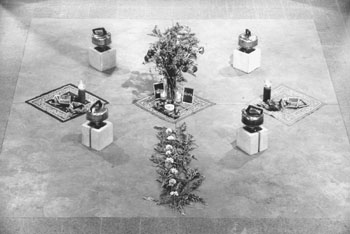Altared States
Spirited Discussion: "Peligro Raza: Peligro y Ternuda" (Danger and Tenderness) by Carlos Perez is one of the Mexican altars on display at the MAH's Feast of the Dead exhibit.
Passion, danger and tenderness merge in eloquent statements on Latino experience
By Suzanne Baker
ON THE THIRD floor of the Museum of Art and History is a table covered with a shimmering marigold cloth, littered with candles, candy, clay and plastic figurines, a tiny coffee cup, pictures, a cigar and a rotting banana. It's not the bric-a-brac section at the Salvation Army, although the Feast of the Dead (El Fustin de los Muertos) arrangement looks like an artful thrift-store display. Eclectic and highly personalized, the work is Silvia Carballa's altar to the dead, dedicated to "My Mother and Cuba." The gaudy and bizarre display is one of the many altars on view through Nov. 11 at the exhibition organized by Arte Latino.
Using the traditional Mexican Dia de los Muertos (Day of the Dead) altar as a jumping-off point, Santa Cruz County and Greater Bay Area artists combine tradition and contemporary aesthetics to punctuate their political and personal statements. Yellow marigold flowers, traditionally symbolizing life, run like a sunny refrain through almost every piece.
Altars festooned with flowers, cookies, candles and favorite treats of the deceased make each altar a highly personalized conversation between the living and the dead. The community altar in the atrium of the museum is the closest example to the traditional Dia de los Muertos altar. One interactive exhibit is the Desk of the Dead, which invites visitors to write letters to the deceased.
On Saturday, the museum sponsors Santa Cruz's own Dia de los Muertos, featuring multicultural food, music and art workshops from noon to 5pm, followed by an evening of art and poetry from 8pm to midnight. At 8pm, Carlos Perez will fire up the tea kettles of his altar/performance art. Perez's contemporary musing on gang tension, Peligro y ternuda (Danger and Tenderness), is one of the most visually arresting of the exhibit. Combining images of violence--shattered picture frames, barbed wire--with unifying images of braided blue, red and brown bandannas and marigolds, it reminds Latino communities that "there is something we all share in common, and that's that we're all brown."
This page was designed and created by the Boulevards team.

Robert Scheer
From the October 31-November 6, 1996 issue of Metro Santa Cruz
Copyright © 1996 Metro Publishing, Inc.
![[MetroActive Arts]](/arts/gifs/art468.gif)